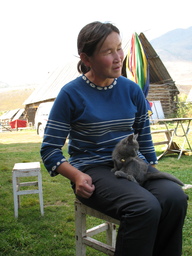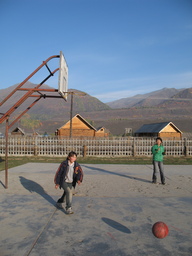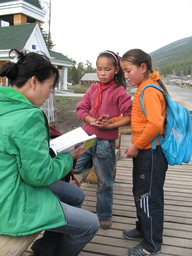
Mei Hua with
Kitten on Lap
 Mei Hua with Kitten on Lap |
I don't know why Tuvan culture still seems exotic to me. I've traveled extensively throughout areas near Tuva--such as Kazakhstan and Mongolia--places which have cultural overlap. Kazakhs, Mongols, Tuvans--these societies share so much. Maybe I'm intrigued because the number of Tuvans on the planet is even smaller than that of the other two ethnicities. Maybe it's because I haven't yet been to Tuva itself. Maybe it's because the only things I've heard in the west about Tuva are romantic descriptions of a remote land of hoomei throat singers and horseback-riding nomads. Whatever the reason, I've been meeting lots of Tuvan people in the area and still find them fascinating.
Meenday and I have been spending recent days visiting villages in the area around Lake Kanas. Remote as the area is, we're far from alone: there are lots of Chinese tourists around as well. People from other parts of China regard the Altai area as unique not just for its mix of ethnicities, but also for its setting. Many people I've spoken with over the years buy into a certain hype surrounding Kanas. "The lake and surrounding mountains are so beautiful: it's positively Alpine. You'll think you're in Switzerland!"
Alpine setting or not, there are many reminders that a visit to this area must be within China and in no other country. One example: the main attraction tourists visit is atop a large hill overlooking Lake Kanas. A new pagoda is presently under construction atop the peak. Rather than following trails to climb the hill, tourists walk up a stairway that has been laid along the hillside. Painted on the right side of every step is a sequence number indicating how many steps the tourist has climbed.
Numbering each of a thousand steps up a mountain seems like a practice that feels totally normal throughout China--but I suspect is unlikely to be followed most other parts of the world.
I will admit that the natural beauty around Lake Kanas is nice. I do appreciate the contrast of this setting to the grit and bustle that is the norm around so many other parts of China. However, having grown-up in the western United States the area strikes me as pretty--but not phenomenal. I'm more intrigued by the local mix of cultures here than by the scenery.
 1-on-1 Basketball: Tuvan vs. Mongol |
When buying stamps in Khom-Khanas, I couldn't place the ethnicity of the woman on the other side of the desk. (The post office, incidentally, was a tiny shack with a side business selling knock-off Oreos--one more indicator of still being in China.) The postal worker had the most beautiful cloudy-grey eyes. She didn't appear Kazakh. I suspected that she wasn't Tuvan. The other logical option would have been Mongol, but Meenday wasn't speaking in Mongolian with her. I asked what she was.
"Oh, I'm Han Chinese," was her reply.
"Really?" I couldn't hide my disbelief.
"Well, my grandfather was Russian. But my mother was full-Chinese, so my identity card states, 'Han'."
It seems like everybody here speaks at least three totally different languages. In the process of finding a guesthouse to stay in Meenday and I were driven through town on the backs of two motorcycles. Chatting with my driver in standard Chinese, I enquired about his background and language abilities. "I'm Hui," he said. (The Hui are Chinese Muslims with their own dialect.)
"Do you speak anything else?", I asked.
"Oh, I can speak Kazakh. I can speak Tuvan."
"How about Mongolian?"
"Nah, can't do that one."
Meeting him was a first for me. Most of the ethnic Chinese I've met in Xinjiang are recent arrivals from eastern parts of the country who have no ability in local minority langugages. Few of the Chinese families living in Xinjiang today have history in the area going back more than a couple generations. There's little reason for recent settlers from eastern China to integrate into or adopt the local culture.
 Meenday Reads Textbooks of Tuvan Schoolgirls |
By all indications, that medium will soon be replaced by Chinese--probably with this generation. As anecdotal evidence, take Mei Hua, a woman who has opened a small guesthouse and restaurant here in Khom-Khanas. Though she too was educated in Mongolian, we spoke with each other in Chinese. When I asked what her name was, she replied, "Mei Hua".
"No, no... not your Chinese name. What's your Tuvan name?", I asked.
"Oh, my father didn't give me a Tuvan name! In fact, he didn't give any of us Tuvan names. He gave my brothers both Mongol names. I would have much prefered that..."
I asked Mei Hua some of the basics of speaking Tuvan. Most of the sounds were completely alien to me. However, I was surpised that I could detect some overlap with Uighur. The Tuvan phrase for "How are you (pl.)?" is something like "Amar jaghay salar?" Uighur also uses "salar" to address multiple people.
Language seems to be the main difference setting the Tuvans apart. The traditional lifestyle here strikes raised-in-the-city me as exotic at so many levels--the horses, the yurts, the nomadic lifestyle. But it's not just the Tuvans: all local people in this area--Kazakhs, Mongols, and Tuvans alike--largely follow similar customs.
I'm still searching for what elements other than language that mark Tuvan culture as distinct from that of the other folks in the region. Even if I don't find anything unique over my short stay here, I'm still excited to be spending time in this area, meeting Tuvan upon Tuvan.